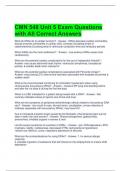CMN 548 Unit 5 Exam Questions
with All Correct Answers
What do DRAs do to cardiac function? - Answer- -DRAs decrease cardiac contractility,
disrupt enzymes contractility in cardiac cells, increase circulating levels of
catecholamines & prolong atrial & ventricular conduction time and refractory periods
Which DRAs are the most cardiotoxic? - Answer- -Low potency DRAs cause most
cardiotoxicity
What are the potential cardiac complications for the use of haloperidol (Haldol)? -
Answer- may cause abnormal heart rhythm, ventricular arrhythmias, torsades de
pointes, & sudden death when injected IV
What are the potential cardiac complications associated with Pimozide (Orap)? -
Answer- may prolong QTc interval and has been associated with torsades de pointes &
sudden death
What is the recommended monitoring for orthostatic hypotension when using
intramuscular low-potency DRAs? - Answer- -measure BP lying and standing before
and after the 1st dose & during the first few days
When is a CBC indicated for a patient being treated with a DRA? - Answer- -Not
routinely indicated unless pt reports sore throat and fever
What are the symptoms of peripheral anticholinergic effects related to low-potency DRA
use? - Answer- -dry mouth & nose, blurred vision, constipation, urinary retention &
midriasis (especially with low-potency DRAs), may have N/V.
Due to increased prolactin levels caused by D2 blockade, what physical signs can be
seen in both men and women? - Answer- -Breast enlargement, galactorrhea,
amenorrhea, inhibited orgasm in women & men
List the severe symptoms of overdose of DRAs. - Answer- -sxs: CNS depression, EPS,
mydriasis, rigidity, restlessness, decreased DTRs, tachycardia & hypotension
-severe sxs: delirium, coma, respiratory depression & seizures
What are the contraindications for using DRAs? - Answer- 1. hx serious allergic
response
2. possible ingestion of substance that will interact w/ the antipsychotic to induce CNS
depression
,3. presence of severe cardiac abnormality
4. high risk for seizures
5. presence of narrow angle glaucoma or prostatic hypertrophy if drug with high
anticholinergic activity will be used
6. presence or hx of tardive dyskinesia
Describe treatment resistance in patients with psychotic disorders. What is
recommended for these patients? - Answer- -Tx resistance: defined as failure on at
least two adequate trials of antipsychotics from two pharmacologic classes
-Clozapine has been shown to be effective for people that have failed with DRAs
What are the FDA recommendations for monitoring patients who are prescribed SGAs?
- Answer- •Weight and height (for BMI)
•Waist circumference (at level of the umbilicus)
•BP
•Fasting plasma glucose
•Fasting lipid profile
what medications are irreversible MAOIs (MAOA&B and MAOB MAOB)? - Answer-
Isocarboxazid (Marplan), Phenelzine (Nardil), Tranylcypromine (Parnate), Selegiline
Transdermal (Emasam)
A single dose of irreversible MAOIs may persist in its inhibition of MAO for how long? -
Answer- 2 weeks
What are the most frequent adverse effects of irreversible MAOIs? - Answer- MAOA&B:
dizziness, drowsiness, fatigue, headache (without increased BP), hyperreflexia, & sleep
disturbances
Reversible MAOIs (RIMAs) Include what medication? - Answer- Maclobemide (Manerix)
How long will it take to recover MAO activity after a final dose of RIMA? - Answer- 24-48
hours
What are the most frequent adverse effects of RIMAs? - Answer- orthostatic
hypotension, insomnia, weight gain, edema & sexual dysfunction, insomnia
tx by dividing doses, not giving after dinner, and using trazodone
MAOIs are used to treat what conditions? - Answer- Depression, bipolar depression,
panic disorder, social phobia, bulimia, PTSD, angina pain, atypical face pain, migraine,
ADHD, idiopathic orthostatic HTN, & depression r/t brain injury
Reversible MAO-A (RIMA) used to treat: - Answer- MDD, dysthymic, chronic
Irreversible MAOA&B used to treat: - Answer- Depression, atypical
MDD, unresponsive to other antidepressants
, Irreversible MAO-B used to treat: - Answer- MDD in adults
What is the treatment for MAOI induced orthostatic hypotension? - Answer- •Avoidance
of caffeine, intake of 2L of fluid/day, addition of dietary salt, adjustment of HTN meds,
support stockings
•fludrocortisone 0.1-0.2mg/day for severe cases
•Advise pts to get out of bed slowly
How long should the Psychiatric Nurse Practitioner wait to begin another treatment for
depression when stopping an MAOI to begin either another MAOI or an SSRI? -
Answer- When changing from one MAOI to another taper and stop use of the first drug
for 10-14 days before beginning the second drug
How long should the PNP wait to begin an MAOI after discontinuing a patient from
fluoxetine (Prozac)? - Answer- Don't use within 5 weeks of prozac
Describe potential complications for using MAOIs for patients who have Bipolar I and
Schizophrenia. - Answer- Induction of mania in persons in the depressed phase of BPI
& triggering psychotic decompensating in persons w/ schizophrenia
What are the symptoms of a tyramine-induced hypertensive crisis? - Answer- Results
from inactive GI metabolism of dietary Tyramine due to the MAOI's
Sxs: HA usually 1st sx, severe HTN, stiff neck, diaphoresis, nausea, vomiting
Management: a-adrenergic antagonists such as phentolamine (regitine) or
chlorpromazine (thorazine) they will lower BP w/in 5 minutes. IV furosemide (Lasix) to
reduce fluid load, and B-adrenergic receptor agonists for tachycardia. SL nifedipine
(Procardia) can be given.
Tyramine containing foods should be avoided for how long after discontinuing an
irreversible MAOI? - Answer- 2 weeks
Tyramine containing foods should be avoided for how long after discontinuing an
reversible MAOI? - Answer- High concentrated tyramine foods should be avoided for 3
days after last dose
List the symptoms of the discontinuation syndrome associated with abrupt withdrawal of
MAOIs. How would the PNP prevent this? - Answer- IRREVERSIBLE MAOI's: can
occur 1-4 days after discontinuation
•sxs: self limiting consisting of arousal, mood disturbances, & somatic symptoms
•To aovid: D/c gradually tapered over several weeks
List the symptoms of the discontinuation syndrome associated with abrupt withdrawal of
MAOIs. How would the PNP prevent this? - Answer- REVERSABLE MAOI's: No
discontinuation syndrome evident




